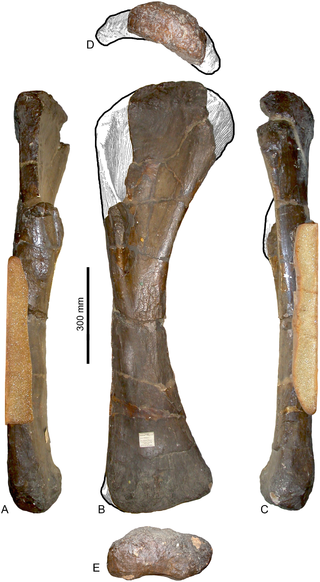Related Research Articles
Genus is a taxonomic rank used in the biological classification of living and fossil organisms as well as viruses. In the hierarchy of biological classification, genus comes above species and below family. In binomial nomenclature, the genus name forms the first part of the binomial species name for each species within the genus.

In taxonomy, binomial nomenclature, also called binary nomenclature, is a formal system of naming species of living things by giving each a name composed of two parts, both of which use Latin grammatical forms, although they can be based on words from other languages. Such a name is called a binomial name, a binomen, binominal name, or a scientific name; more informally it is also historically called a Latin name. In the ICZN, the system is also called binominal nomenclature, "binomi'N'al" with an "N" before the "al", which is not a typographic error, meaning "two-name naming system".

In biology, a type is a particular specimen of an organism to which the scientific name of that organism is formally associated. In other words, a type is an example that serves to anchor or centralizes the defining features of that particular taxon. In older usage, a type was a taxon rather than a specimen.
The abbreviation cf. is used in writing to refer the reader to other material to make a comparison with the topic being discussed. Style guides recommend that "cf." be used only to suggest a comparison, and the words "see" or "vide" be used generally to point to a source of information.

Incertae sedis or problematica is a term used for a taxonomic group where its broader relationships are unknown or undefined. Alternatively, such groups are frequently referred to as "enigmatic taxa". In the system of open nomenclature, uncertainty at specific taxonomic levels is indicated by incertae familiae, incerti subordinis, incerti ordinis and similar terms.
In binomial nomenclature, a nomen dubium is a scientific name that is of unknown or doubtful application.

Pelorosaurus is a genus of titanosauriform sauropod dinosaur. Remains referred to Pelorosaurus date from the Early Cretaceous period, about 140-125 million years ago, and have been found in England and Portugal. Thomas Holtz estimated its length at 24 meters.
Botanical nomenclature is the formal, scientific naming of plants. It is related to, but distinct from taxonomy. Plant taxonomy is concerned with grouping and classifying plants; botanical nomenclature then provides names for the results of this process. The starting point for modern botanical nomenclature is Linnaeus' Species Plantarum of 1753. Botanical nomenclature is governed by the International Code of Nomenclature for algae, fungi, and plants (ICN), which replaces the International Code of Botanical Nomenclature (ICBN). Fossil plants are also covered by the code of nomenclature.

Cetiosaurus meaning 'whale lizard', from the Greek keteios/κήτειος meaning 'sea monster' and sauros/σαυρος meaning 'lizard', is a genus of herbivorous sauropod dinosaur from the Middle Jurassic Period, living about 168 million years ago in what is now Britain.

Lametasaurus named for the Lameta Formation, Jabalpur, India, is the generic name given to a possibly chimeric dinosaur species. The type species is L. indicus.
The Botanical and Zoological Codes of nomenclature treat the concept of synonymy differently.

In taxonomy, an undescribed taxon is a taxon that has been discovered, but not yet formally described and named. The various Nomenclature Codes specify the requirements for a new taxon to be validly described and named. Until such a description has been published, the taxon has no formal or official name, although a temporary, informal name is often used. A published scientific name may not fulfil the requirements of the Codes for various reasons. For example, if the taxon was not adequately described, its name is called a nomen nudum. It is possible for a taxon to be "undescribed" for an extensive period of time, even if unofficial descriptions are published.
Sensu is a Latin word meaning "in the sense of". It is used in a number of fields including biology, geology, linguistics, semiotics, and law. Commonly it refers to how strictly or loosely an expression is used in describing any particular concept, but it also appears in expressions that indicate the convention or context of the usage.
In biological classification, a species inquirenda is a species of doubtful identity requiring further investigation. The use of the term in English-language biological literature dates back to at least the early nineteenth century.

Species affinis is taxonomic terminology in zoology and botany. In open nomenclature it indicates that available material or evidence suggests that the proposed species is related to, has an affinity to, but is not identical to, the species with the binomial name it comes after. The Latin word affinis can be translated as "closely related to", or "akin to".

This is a list of terms and symbols used in scientific names for organisms, and in describing the names. For proper parts of the names themselves, see List of Latin and Greek words commonly used in systematic names. Note that many of the abbreviations are used with or without a stop.
References
- ↑ S. C. Matthews (1973), "Notes on open nomenclature and on synonymy lists" (PDF), Palaeontology, 16 (4): 713–719, retrieved 24 March 2016
- 1 2 3 Bengtson, Peter (1988). "Open nomenclature" (PDF). Palaeontology. 31 (1): 223–227. Archived from the original (PDF) on 14 December 2010. Retrieved 23 January 2011.